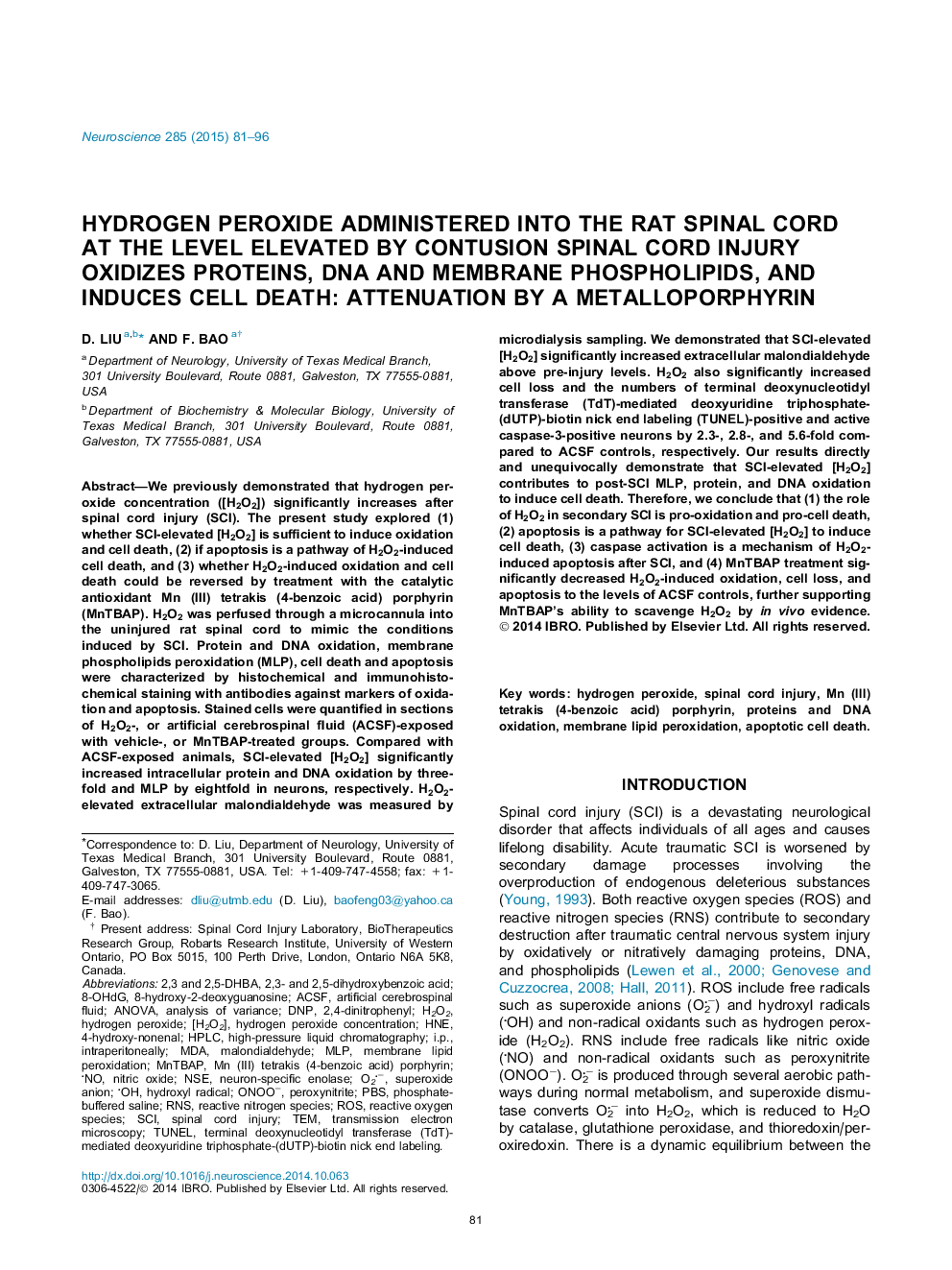| کد مقاله | کد نشریه | سال انتشار | مقاله انگلیسی | نسخه تمام متن |
|---|---|---|---|---|
| 6273186 | 1614791 | 2015 | 16 صفحه PDF | دانلود رایگان |
عنوان انگلیسی مقاله ISI
Hydrogen peroxide administered into the rat spinal cord at the level elevated by contusion spinal cord injury oxidizes proteins, DNA and membrane phospholipids, and induces cell death: Attenuation by a metalloporphyrin
دانلود مقاله + سفارش ترجمه
دانلود مقاله ISI انگلیسی
رایگان برای ایرانیان
کلمات کلیدی
MDA4-hydroxy-nonenalMLPMnTBAPi.p.HNE8-OHdGDNPaCSF2,4-dinitrophenyl - 2،4-dinitrophenyl8-Hydroxy-2-deoxyguanosine - 8-هیدروکسی-2-دگزسی گوانوزینHydrogen peroxide - آب اکسیژنهanalysis of variance - تحلیل واریانسANOVA - تحلیل واریانس Analysis of varianceIntraperitoneally - داخل صفاقیmalondialdehyde - مالون دی آلدهیدartificial cerebrospinal fluid - مایع مغزی نخاعی مصنوعیH2O2 - هیدروژن پراکسیدMembrane lipid peroxidation - پراکسیداسیون لیپید غشاییhigh-pressure liquid chromatography - کروماتوگرافی مایع با فشار بالاHPLC - کروماتوگرافی مایعی کارا
موضوعات مرتبط
علوم زیستی و بیوفناوری
علم عصب شناسی
علوم اعصاب (عمومی)
پیش نمایش صفحه اول مقاله

چکیده انگلیسی
We previously demonstrated that hydrogen peroxide concentration ([H2O2]) significantly increases after spinal cord injury (SCI). The present study explored (1) whether SCI-elevated [H2O2] is sufficient to induce oxidation and cell death, (2) if apoptosis is a pathway of H2O2-induced cell death, and (3) whether H2O2-induced oxidation and cell death could be reversed by treatment with the catalytic antioxidant Mn (III) tetrakis (4-benzoic acid) porphyrin (MnTBAP). H2O2 was perfused through a microcannula into the uninjured rat spinal cord to mimic the conditions induced by SCI. Protein and DNA oxidation, membrane phospholipids peroxidation (MLP), cell death and apoptosis were characterized by histochemical and immunohistochemical staining with antibodies against markers of oxidation and apoptosis. Stained cells were quantified in sections of H2O2-, or artificial cerebrospinal fluid (ACSF)-exposed with vehicle-, or MnTBAP-treated groups. Compared with ACSF-exposed animals, SCI-elevated [H2O2] significantly increased intracellular protein and DNA oxidation by threefold and MLP by eightfold in neurons, respectively. H2O2-elevated extracellular malondialdehyde was measured by microdialysis sampling. We demonstrated that SCI-elevated [H2O2] significantly increased extracellular malondialdehyde above pre-injury levels. H2O2 also significantly increased cell loss and the numbers of terminal deoxynucleotidyl transferase (TdT)-mediated deoxyuridine triphosphate-(dUTP)-biotin nick end labeling (TUNEL)-positive and active caspase-3-positive neurons by 2.3-, 2.8-, and 5.6-fold compared to ACSF controls, respectively. Our results directly and unequivocally demonstrate that SCI-elevated [H2O2] contributes to post-SCI MLP, protein, and DNA oxidation to induce cell death. Therefore, we conclude that (1) the role of H2O2 in secondary SCI is pro-oxidation and pro-cell death, (2) apoptosis is a pathway for SCI-elevated [H2O2] to induce cell death, (3) caspase activation is a mechanism of H2O2-induced apoptosis after SCI, and (4) MnTBAP treatment significantly decreased H2O2-induced oxidation, cell loss, and apoptosis to the levels of ACSF controls, further supporting MnTBAP's ability to scavenge H2O2 by in vivo evidence.
ناشر
Database: Elsevier - ScienceDirect (ساینس دایرکت)
Journal: Neuroscience - Volume 285, 29 January 2015, Pages 81-96
Journal: Neuroscience - Volume 285, 29 January 2015, Pages 81-96
نویسندگان
D. Liu, F. Bao,